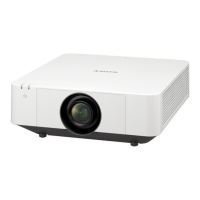5
Input (page 9)
a INPUT A
Video: RGB/YPBPR input terminal
(RGB/YP
BPR)
Audio: Audio input terminal (AUDIO)
b INPUT B
Video: DVI-D input terminal (DVI-D)
Audio: Audio input terminal (AUDIO)
c INPUT C
Video: HDMI input terminal (HDMI)
Audio: HDMI input terminal (HDMI)
d INPUT D
HDBaseT terminal
e VIDEO (VIDEO IN)
Video: Video input terminal
Audio: Audio input terminal (AUDIO)
• The audio input terminals of the projector are
for output to external equipment.
Connect
external audio equipment to output audio
(page 12).
• The audio inputs of INPUT A, INPUT B, and
VIDEO are shared.
Output (page 12)
f OUTPUT A
Video: RGB/YPBPR output terminal
(RGB/YP
BPR)
g OUTPUT B
Video: DVI-D output terminal (DVI-D)
h AUDIO OUT
Audio: Audio output terminal (AUDIO)
These terminals output projected images or
audio. As for images, the signal input from
INPUT A is output from OUTPUT A, and the
signal input from INPUT B is output from
OUTPUT B. However, if the signal input from
INPUT B is protected by HDCP, the signal is
not output from OUTPUT B. As for audio,
when INPUT A or B, or VIDEO is selected, the
audio signal input from the audio input
terminal is output; when INPUT C or D is
selected, the audio signal input from the
selected input terminal is output.
Others
i RS-232C terminal
RS-232C compatible control terminal
j LAN terminal (page 13)
k CONTROL S input terminal (DC
power supply) (CONTROL S)
Connects to the CONTROL S output
terminal on the supplied Remote
Commander with a connecting cable
(stereo mini plug (not supplied)) when
using it as a wired Remote Commander.
You do not need to install batteries in the
Remote Commander, as the power is
supplied from this terminal.
l AC IN (-) socket
Connects the supplied AC power cord.
Terminals
Notes
Note

